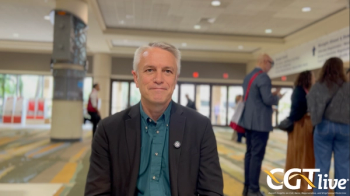
Astrocyte Cell Therapy Well-Tolerated in Amyotrophic Lateral Sclerosis
Postmortem analyses revealed cell survival and GDNF production in transplanted areas.
An allogeneic human neural progenitor cell therapy transduced with glial cell line-derived neurotrophic factor (GDNF) and differentiated to astrocyte cells, termed CNS10-NPC-GDNF, was found to be well-tolerated and produced GDNF in participants with
"Using stem cells is a powerful way to deliver important proteins to the brain or spinal cord that can't otherwise get through the blood-brain barrier," senior author Clive Svendsen, PhD, professor, Biomedical Sciences and Medicine and executive director, Cedars-Sinai Board of Governors Regenerative Medicine Institute, said in a statement.2 "We were able to show that the engineered stem cell product can be safely transplanted in the human spinal cord. And after a 1-time treatment, these cells can survive and produce an important protein for over three years that is known to protect motor neurons that die in ALS."
The phase 1/2a study, conducted at Cedars-Sinai, involved investigators transplanting CNS10-NPC-GDNF unilaterally into the lumbar spinal cord of 18 participants with ALS.1 Participants had to have a disease duration of at least 3 years, evidence of lumbar spinal motor neuron involvement either clinically or on electromyography, and a supine forced vital capacity of more than 60%. The 18 participants were randomized to receive 10 unilateral injections of 200,000 cells per site for a total of 2,000,000 cells in the first dose cohort (n = 9) or 10 unilateral injections of 500,000 cells per site for a total of 5,000,000 cells in the second dose cohort (n = 9). Cells were targeted via MRI to the transition zone between the dorsal and ventral horns as preclinical rodent data predicted that cells would migrate ventrally into the motor neuron pool.
"GDNF on its own can't get through the blood-brain barrier, so transplanting stem cells releasing GDNF is a new method to help get the protein to where it needs to go to help protect the motor neurons," co-lead author Pablo Avalos, MD, associate director, Translational Medicine, Cedars-Sinai Board of Governors Regenerative Medicine Institute, added to the statement.2 "Because they are engineered to release GDNF, we get a 'double whammy' approach where both the new cells and the protein could help dying motor neurons survive better in this disease."
READ MORE:
The trial met its primary outcome of safety, and no adverse events (AEs) were observed due to surgery or cell transplantation.1 Participants stayed in the hospital for 5 days and were then followed for 1 year with assessments at 1, 2, 3, 6, 9 and 12 months post-transplantation. Most patients (89% of the low-dose cohort and 67% of the high-dose cohort) had dysesthesia, paresthesia, and/or pain and discomfort in the region innervated by the surgery site immediately after the procedure, most likely due to needle passes. Lower extremity pain on the treated side lasted more than 6 months in 9 participants and 5 participants had pain severity scores of over 5.
Patients received immunosuppression to support engraftment of the allogeneic therapy. Twelve patients had an unaltered course of immunosuppression, 2 patients discontinued the course, and 4 had an altered course including breaks and substitutions. Participants experienced common AEs associated with ALS, immunosuppression, and surgery, including falls, extremity pain, nausea, back pain and muscular weakness.
"We're excited that we proved safety of this approach, but we need more patients to really evaluate efficacy, which is part of the next phase of the study," co-lead author J Patrick Johnson, MD, co-medical director, Spine Center, and vice chair, Neurosurgery, Cedars-Sinai, added.2 "Proving that we have cells that can survive a long time and are safe in the patient is a key part in moving forward with this experimental treatment."
Secondary outcome measures evaluated the treatment’s effect on motor function in the treated vs untreated leg.1 Participants progressed at a mean rate of 1.2 points per month (95% CI, –1.5 to –0.9) on ALS Functional Rating Scale Revise scores, typical with natural history. The mean score was 36 at screening (range, 29–40). Investigators used an accurate test of limb isometric strength (ATLIS) device and found that on average, treated legs lost strength at a slower rate than untreated legs (adjusted mean difference, 0.22% [95% CI, –0.09 to 0.53]; P = .16). The trend was not statistically significant, but the largest relative difference was observed in the low-dose cohort at 12 months and the high-dose cohort showed a consistently slower rate of decline in the treated leg at all time points.
Investigators assessed post-mortem samples (within 24 hours) from brains and spinal cords of 13 participants that died of ALS progression between 14 and 42 months after transplant. They confirmed cell survival only on the transplanted side via DNA signal. Survival was more prominent in the dorsal segment. Immunohistochemistry with the IBA1 microglia marker demonstrated little or no immune reaction in the spinal cord in all but 1 participant, compared to extensive microglial responses and IBA1 staining in descending motor neuron tracts likely due to upper motor neuron death and lateral column degeneration. Investigators also found benign Schwann cell neuromas in the transition zone in 9 participants postmortem.
"We are very grateful to all the participants in the study," Svendsen added.2 "ALS is a very tough disease to treat, and this research gives us hope that we are getting closer to finding ways to slow down this disease."
REFERENCES
1. Baloh RH, Johnson JP, Avalos P, et al. Transplantation of human neural progenitor cells secreting GDNF into the spinal cord of patients with ALS: a phase 1/2a trial. Nat Med. Published online September 5, 2022. https://doi.org/10.1038/s41591-022-01956-3
2. Stem cell-gene therapy shows promise in ALS safety trial. News release. Cedars-Sinai Medical Center. September 5, 2022. https://medicalxpress.com/news/2022-09-stem-cell-gene-therapy-als-safety.html
Newsletter
Stay at the forefront of cutting-edge science with CGT—your direct line to expert insights, breakthrough data, and real-time coverage of the latest advancements in cell and gene therapy.



































